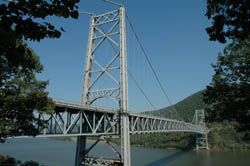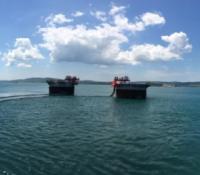A weight restriction has been placed on a major UK suspension bridge during work that will mitigate deterioration of the main cables by managing the number of heavy vehicles using the crossing.
National Highways, the government-owned company that modernises, maintains and operates England’s major roads, has said that from the end of May, heavy goods vehicles (HGVs) weighing more than 7.5t cannot use the M48 Severn Bridge.

The Severn Bridge between Wales and England will be under a 7.5t weight restriction from late May. Credit: National Highways.
The Grade I listed Severn Bridge over the River Severn between England and Wales was used by 32,000 vehicles a day in 2004, 3,270 of which were HGVs weighing more than 7.5t. Since the Severn Bridge opened in 1966, HGVs have got larger and heavier, and the amount of traffic has increased, too. These changes mean that the weight of traffic using the bridge is outside the intentions of its design.
An assessment published late last year recommended that National Highways reduce the load on the bridge because the supporting cables were deteriorating.
National Highways will keep the weight restrictions in place for 12 to 18 months while it develops a medium-term solution, possibly involving vehicle numberplate recognition cameras, to keep vehicle loads within safe limits.
Heavier vehicles will use the M4 Prince of Wales Bridge, which lies down river to the south. Certain types of heavy vehicle – including buses, emergency vehicles, recovery trucks and gritters – will still use the Severn Bridge.
In 2020, a 15-year contract for maintenance of the Severn Bridge, the Prince of Wales Bridge and the Avonmouth Bridge was awarded to Amey (link opens in new tab).





